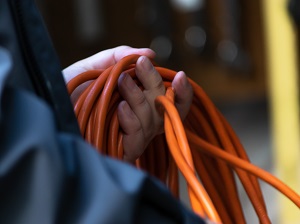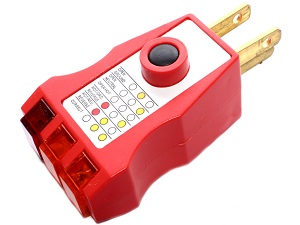Extension cords are common and convenient, but when used without proper safety precautions they can become fire hazards and pose risks to worker safety.

A flexible cord may be damaged by activities on the job, by door or window edges, by staples or fastenings, by abrasion from adjacent materials, or simply by aging. If the electrical conductors become exposed, there is a danger of shocks, burns, or fire.
Inspect extension cords for physical damage before use. Check for cracked or frayed sockets, loose or bare wire, missing grounding prongs, and loose connections. Discard damaged extension cords.
Ground Fault Circuit Interrupters, or GFCIs, are life-saving devices that protect people from electrocution. A GFCI is a fast-acting circuit breaker that senses small imbalances in the circuit caused by current leakage to ground and, in a fraction of a second, shuts off the electricity. It protects against the most common form of electrical shock hazard—the ground fault, and protects against fires, overheating, and destruction of insulation on wiring.

Not all extension cords are the same. It’s important to choose the correct extension cord for the requirements of the task and the work environment. Select extension cords that are rated to handle the wattage of the devices with which they’ll be used. A cord’s gauge indicates its size: The smaller the number, the larger the wire and the more electrical current the cord can safely handle.
Only use extension cords approved by an independent testing laboratory, such as Underwriters Laboratories (UL), Intertek (ETL) or Canadian Standards Association (CSA).
OSHA Standard 1926.416(e) Worn or frayed electric cords or cables shall not be used.
- Consider the length you'll need. Longer cords can't handle as much current as shorter cords of the same gauge.
- Only use extension cords with polarized or three-prong plugs.
- Extension cords can easily become trip and fall hazards if not routed carefully.
- Keep extension cords away from foot traffic to prevent tripping and cord damage.
- For outdoor work, only use extension cords rated for outdoor use.

Never remove the grounding pin on an extension cord plug to try to fit it into a two-prong outlet. Fully insert the extension cord plug into the outlet. When disconnecting an extension cord from a power outlet pull the plug, don’t yank on the cord. Do not secure extension cords to surfaces with staples or nails.
OSHA Standard 1926.416(e)(2) Extension cords shall not be fastened with staples, hung from nails, or suspended by wire.
If any extension cord in use begins to feel hot to the touch, remove it from service immediately. Ensure extension cords are not routed through puddles, standing water or snow. Do not plug or unplug an extension cord while your hands are wet. Use a Ground Fault Circuit Interrupter (GFCI) to protect against any electrical fault.
Do not use multiple extension cords connected together, use a longer extension cord instead. Store extension cords indoors when not in use. Damaged extension cords should be removed from service and disposed of properly.

GFCIs can be used successfully to reduce electrical hazards on the job. Tripping of GFCIs—interrupting current flow—is sometimes caused by wet connectors and tools. It is good practice to limit exposure of connectors and tools to excessive moisture by using watertight or sealable connectors.
A GFCI will not protect a worker from line contact hazards such as 1) holding two “hot” wires, 2) holding a hot and a neutral wire in each hand, or 3) contact with an overhead power line.
OSHA Standard 1926.404(b)(1)(iii)(E)(1-4) All required tests shall be performed before first use; before equipment is returned to service following any repairs; before equipment is used after any incident which can be reasonably suspected to have caused damage (for example, when a cord set is run over); and at intervals not to exceed 3 months, except that cord sets and receptacles which are fixed and not exposed to damage shall be tested at intervals not exceeding 6 months.
GFCIs can pose serious risks if you take for granted they are working correctly. Test GFCIs before their first use, before the first use following repair, after any incident, as well as on a regular basis at least every 3 months. When a GFCI trips, reset and then trip it using either a GFCI tester or the test buttons on the device and make sure this stops the current flow. If the device will not trip open, or if it trips and current continues to flow, the device is defective and must be replaced.

GFCI protection may be anywhere on the circuit as long as it works effectively to protect the worker. Protection may be for the entire circuit, the outlet receptacle, or the extension cord.
For work applications, there are several types of GFCIs available, with some variations:
- The Receptacle Type incorporates a GFCI device within one or more receptacle outlets.
- The Portable Type comes in several styles, all designed for easy transport that incorporate a no-voltage release device that will disconnect power to the outlets if any supply conductor is open.
- The Cord-Connected Type is an attachment plug incorporating the GFCI module. It protects the cord and any equipment attached to the cord. The attachment plug has a non-standard appearance with test and reset buttons. Like the portable type, it incorporates a no-voltage release device that will disconnect power to the load if any supply conductor is open.

.jpg)

.jpg)